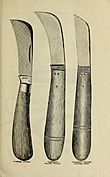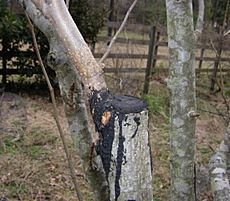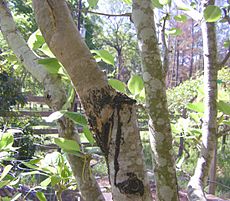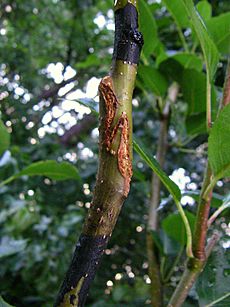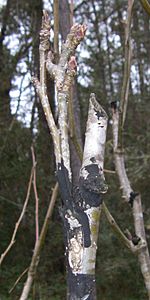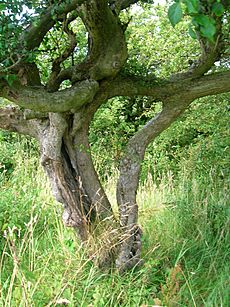Grafting facts for kids
Grafting is a cool way to join two plants together. It's like giving one plant a part of another plant! The two parts then grow as one plant. This is a type of vegetative reproduction, meaning you don't need seeds. People often use grafting for roses and fruit trees.
Grafting works for plants called dicots (most trees and flowers) and gymnosperms (like pine trees). It doesn't work for monocots (like grasses or corn). This is because monocots don't have a special part called a vascular cambium, which is needed for the plants to join. There are many ways to graft, and each way has its own good and bad points.
Contents
Tools for Grafting: What You Need
When you graft, you need the right tools to do it well and keep the plants healthy.
- Cutting Tools: You need very sharp knives to make clean cuts. This helps the plants heal faster and reduces damage. It's also important to keep your tools clean to stop diseases from spreading. Some knives are made just for grafting, like bud-grafting knives. For bigger branches, you might use cleavers or saws.
- Disinfecting Tools: After cutting, you need to clean your tools to kill any germs or diseases. A common cleaner is alcohol. This makes sure the cut area stays healthy.
- Graft Seals: These are materials that cover the grafted area. They help keep the plant from drying out. Good seals are tight enough to hold moisture but loose enough for the plant to grow. Examples include special clay, wax, or tape.
- Tying and Support Materials: These materials hold the two plant parts together firmly. They add support and gentle pressure. This is very important until the plant parts grow together. Materials like strips of cloth, twine, or even small splints can be used.
- Grafting Machines: Grafting can take a lot of time and skill. So, people have invented machines to help! These machines can graft many seedlings very quickly. Some can graft 800 seedlings in just one hour!
Grafting Methods: How Plants Are Joined
There are several different ways to graft plants. Each method is used for different situations and types of plants.
Approach Grafting: Joining Plants Side-by-Side
Approach grafting, also called inarching, is used for plants that are hard to join in other ways. In this method, two plants are grown very close together. Then, parts of them are joined. Both plants keep their own roots and top growth, at least at first. Sometimes, one part is removed later. This method can be done at any time of the year.
Bud Grafting: Using a Single Bud
Bud grafting uses just one bud instead of a whole twig. This is a very common way to graft roses. To do this, a bud is carefully taken from one plant. Then, it's put under the bark of another plant's stem. Any other buds that start to grow from the stem are removed. This method is often used for roses and fruit trees like peaches.
Budwood is a small stick that has several buds on it. These buds can be cut off and used for bud grafting. It's a popular way to grow new citrus trees.
Cleft Grafting: Splitting and Inserting
Cleft grafting is one of the most common ways to graft. It's best done in the spring. This method is good for joining a thin branch (called the scion) to a thicker branch or main stem (called the stock).
First, a small cut is made in the stock, splitting it down the middle. This creates a "cleft." The end of the scion is then cut into a long, pointed wedge shape. This wedge is carefully slid into the cleft. It's important that the inner layers of both parts (called the cambium) touch each other. Often, two scions are put into one cleft to help seal it. Finally, tape is wrapped around the top of the stock to hold the scions. A special wax or sealing compound is added to stop the parts from drying out and to keep water from getting in.
Whip Grafting: Strong and Successful
Whip grafting, also known as whip and tongue grafting, is thought to be the hardest to learn. But it also has the highest chance of success! This is because it creates a lot of contact between the inner layers of the two plant parts. It's often used for fruit trees.
In this method, both the scion and the stock are cut at a slanting angle. Then, a small notch (like a "tongue") is cut into each slanted surface. These "tongues" fit together like puzzle pieces. This creates a strong, interlocking joint. The joined area is then wrapped with tape and covered with wax. This protects it from drying out and from germs. The unique "Z" shape of this graft makes it very strong.
Stub Grafting: Keeping Tree Shape
Stub grafting uses less of the main plant than cleft grafting. It also helps keep the natural shape of the tree. In this method, a small cut is made into a branch. Then, a wedge-shaped scion is pushed into the cut. The scion should be at a slight angle to the main tree. The grafted area is then covered with a grafting compound. After the graft has grown strong, the original branch above the graft is removed.
Four-Flap Grafting: A Complex Method
The four-flap graft, sometimes called a banana graft, is often used for pecan trees. It's known for making a lot of contact between the plant parts, which is good for success. However, it's a tricky graft to learn. It needs the rootstock and scion to be about the same size. The bark of the rootstock is cut and peeled back in four sections, like a peeled banana. The inner wood is then removed.
Awl Grafting: Quick and Simple
Awl grafting uses the fewest tools and takes the least time. It's best done by someone with experience. You use a tool, like a screwdriver, to make a slit in the bark without cutting all the way through. Then, a wedge-shaped scion is inserted into this slit. If the tool goes too deep, it can hurt the scion's chances of survival.
Veneer Grafting: For Thicker Branches
Veneer grafting, or inlay grafting, is used for thicker branches. The scion (the part you're adding) should be about as thick as a pencil. Cuts are made on the side of the branch, not on top, to match the size of the scion. The scion's end is shaped like a wedge, inserted, and then wrapped with tape to give it more strength.
Natural Grafting: When Plants Join Themselves
Sometimes, branches or roots of the same type of tree will join together on their own. This is called inosculation, or natural grafting. It happens when the bark of the roots or branches touches and wears away. This exposes the inner layers, allowing them to grow together.
When roots graft naturally, a group of trees can share water and nutrients. This can help weaker trees. It can also make a bigger root system, which helps trees survive fires or strong winds. For example, Albino redwoods are special trees that don't have chlorophyll. They survive by connecting their roots to normal redwoods and getting food from them!
However, natural grafting can also cause problems. It can allow diseases, like Dutch elm disease, to spread easily from one tree to another. Natural grafting is not common in smaller, softer plants because their roots usually don't live long or grow much thicker.
Images for kids
See also
 In Spanish: Injerto para niños
In Spanish: Injerto para niños



